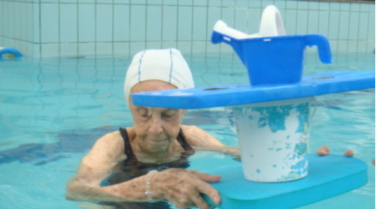Aquatic therapy has long been a valuable resource that we should not lose sight of. There are also many interesting developments in this form of therapy, also well justified for the neurological and geriatric patient. Training of fall prevention, aerobic capacity and influencing neuroplasticity (and the associated (anti) inflammatory processes and cognitive tasks), using the possibilities offered by aquatic therapy is discussed in this article.
Summary
Aquatic therapy is a well-known intervention that now has a large body of knowledge. The effects of the hydrostatic pressure are the basis for important homeostatic adjustments in the brain circulation. As a result, there are neurotrophic effects (such as an increase in anti- inflammatory cytokines and BDNF) that partly form the rationale for exercising e.g. executive functions as part of postural and movement motor skills. This can be important in the context of fall prevention. Water lends itself well to gaining a lot of movement experience (variability), whereby the boundaries of balance can be explored, in a safe and rich environment. Physiological stimuli on land and in water are comparable, if not better in water, which is important for people who have difficulty in achieving this training stimulus on land.
Follow this link to view the article: 2020 Lambeck Lambeck Aquatic Therapy a valuable intervention in neurological and geriatric physiotherapy a narrative review


